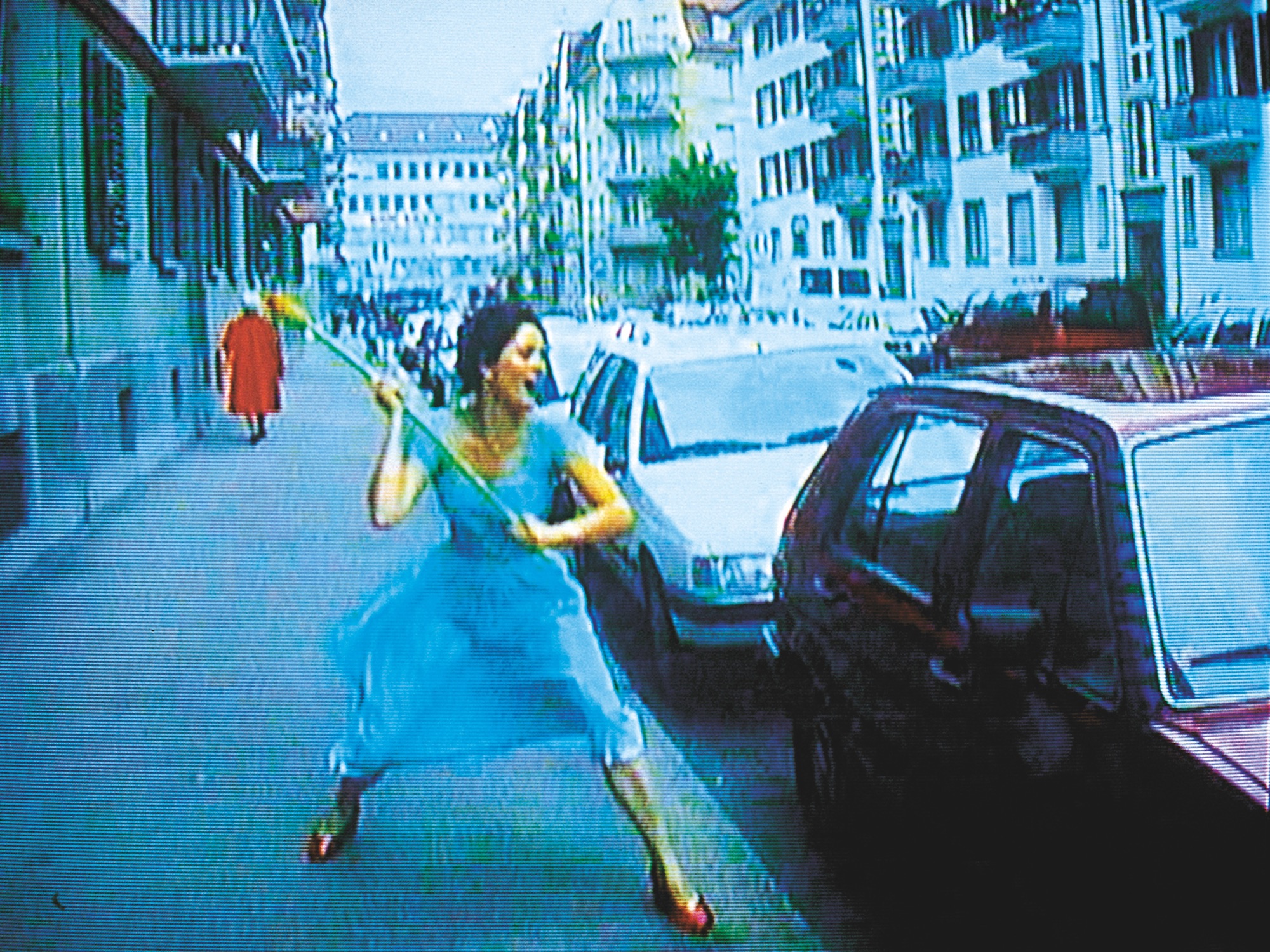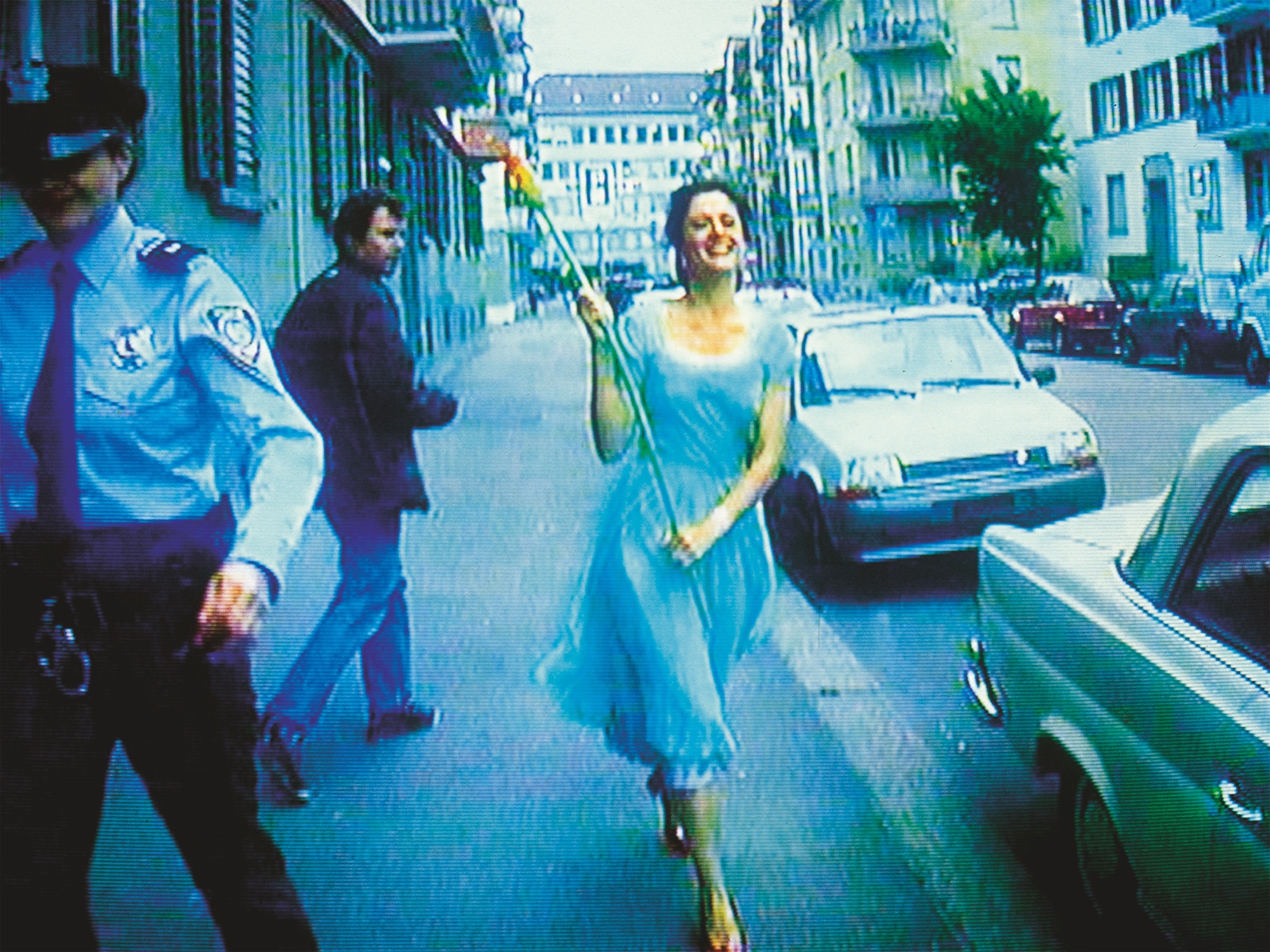
The first time I watched Pipilotti Rist’s Ever Is Over All (1997), I was eighteen years old and on an Art Foundation course. My idea of proper art was paintings, even though every attempt at doing my own made me frustrated and miserable. Rist’s videos were pixelated and full of lurid, glowing colour. They showed me that there were other ways of making good art, even if it looked “bad quality”. By deliberately opting out of newer, slicker technologies, she celebrates the hum of the lo-fi. She elevates colour that bleeds out of its edges, using pixels as a new kind of pointilism. I have yet to see this work in the flesh, but even the computer screen serves to complement its graininess.
The two-channel video was one of her first large-scale installations, but its premise seems simple at first glance. A woman, Rist herself, walks down the street smashing car windows. Except she isn’t angry, and she appears to be causing all of this destruction with a giant flower. She strides along cheerfully, swinging her flower like a baseball bat. Nobody seems to mind—in fact a female policewoman tips her hat at her and smiles. What could have been real-world quickly reveals itself as a set-up, but it was precisely the blurring of this boundary that drew me in. Is she actually doing that? Whose cars are those?
“By deliberately opting out of newer, slicker technologies, she celebrates the hum of the lo-fi”
All this is set against birdsong and a woman’s voice humming, repeated ad infinitum. As she breaks the first window, a distorted piano and a waltz-like electronic beat are introduced. It sounds like someone hitting a drum underwater, with the hummed tune giving the video its lilting, swaying soundtrack.
- Ever is Over All, 1997, audio video installation by Pipilotti Rist (video still) © Pipilotti Rist. Courtesy the artist, Hauser & Wirth and Luhring Augustine
The other half of the projection is a hypnotic and sensual film of a field of red hot poker plants, the same flower she uses as her weapon. Rist says she chose them because they never fall over in the wind. She films them from ground level, as if from the perspective of a bug. Tiny movements become huge swooping gestures as they are blown up and projected, ten times their size. The effect is disorienting, but allows us into a view of the landscape that we don’t usually see, like rolling around in grass and looking up at the sky.
Bodies in Rist’s work are always depicted in relation to nature. In both Sip My Ocean and more recently 4th Floor to Mildness, we see limbs tangled up in seaweed, bellies hovering on water and girls swimming through kaleidoscopic scenes. The experience of watching these videos can feel like realigning with nature. If nothing else, they give visitors the chance to lie down in a gallery. They are a necessary antidote to the frenetic pace of modern visual culture. They act as an affront to the monetization of the female body and the increasingly pervasive advertising techniques that come with it.
Rist’s figures, amorphous and in flux in her underwater works, resist reality. Similarly, in Ever is Over All, the world moves at half its usual speed, and Rist glides through the street as if floating downstream. The smashing of the windows disrupts the sleepy pace of the video, but is prolonged through slow motion, adding to the satisfaction of watching them break. This is perhaps why I return to this video so often; it’s cathartic, like a form of vicarious rebellion.

“Rist’s work acts as an affront to the monetization of the female body and the increasingly pervasive advertising techniques that come with it”
By undercutting traditional, Dorothy-esque representations of femininity, Rist presents us with a picture of freedom. Our protagonist seems to exist within this lawless paradise, in which the police are on our side. What was an act of violence has turned into something sunny and euphoric. This image of the transgressive woman is something we are familiar with now, but what’s different in Rist’s work is the surreal and dream-like setting.
She isn’t going anywhere—the street could go on forever for all we know, and there seems to be no real motive to her actions. Rather than depoliticizing the work, this stands to make it more universal; you can project your own narrative on to her. Because it takes place somewhere on the edge of reality, there are no rules and no representations to transgress. She seems to exist without any preconceptions about what she should or should not be doing, and maintains her steady smile throughout.







